Basketball Defense - Man-to-Man Pressure Defense (Part 1)
By Dr. James Gels, From the Coach’s Clipboard Basketball Playbook"Helping coaches coach better..."
Disclosure: This page contains affiliate links, which means that Coach's Clipboard receives a small commission (at no cost to you) if you make a purchase using these links.

Man-to-man defense enables us to pressure the ball ("on-ball defense"), while still protecting the basket ("helpside defense"). I love watching a well-coached team that plays great man-to-man pressure defense. Good man-to-man defense is a team defense, not just five individuals guarding their own man, but five players working together. Quote: "The best man defense looks like a zone and the best zone defense looks like a man."
This very detailed presentation is broken down into three parts. This page explains the important, basic man-to-man fundamentals.
Also see:
Man-to-Man Pressure Defense (Part 2) - defending the low post, cutters, and special situations.
Man-to-Man Pressure Defense (Part 3) - defending screens (pick and roll, perimeter lateral screens, post screens, down-screens and back-screens.
Contents
- Force to the sideline and baseline
- Deny the Wing Pass?
- Keeping pressure on the ball, on-ball defense
- Positioning off the ball - Deny, Helpside, Help and Recover
- Help and Recover... stop the seams
- Point-guard dribble-penetration
- Baseline dribble-penetration
Man-to-Man Defense - Force to the sideline and baseline.
We teach on-ball defenders to force the ball toward the sideline and then down to the baseline. On the baseline, we stop penetration and try to trap. Forcing the ball to one side allows you to establish your helpside defense. When the ball is at the top of the key in the middle, the low defenders must play "straight up" and you have to defend the entire court.But once the ball goes to the side, weakside defenders move into helpside position (see below), deny the pass into the post, and help prevent dribble-penetration. When the ball is in the corner, we only have to defend half of the court and can load all five defenders on that side. On a long skip pass to the opposite side, there is usually enough time (while the ball is in the air) for the defense to quickly rotate back.
How do you force the ball to the side? The on-ball defender at the top of the key, or on the wing, must close-out on the ball-handler with his sideline (outside) foot back and the middle (inside) foot forward. Have the defender put a little more of his/her weight on the front foot, so that if the ball-handler makes a quick dribble move toward the outside, the defender can push back off that front foot more quickly.
Some coaches deny the point to wing pass, but for us it makes more sense to let the pass go to the wing since we want to force to the side. Once the ball is on the wing, we deny the pass back out to the point, and force the ball even further into the corner.
Now realize that most often the pass to the low post comes from the wing. And once the ball gets into the low post, bad things can happen... they either score or we foul. So it is important to teach the post defenders to front the low post as the ball moves to the wing and corner areas. We must deny that pass into the post.
But what about the "over-the-top" lob pass? First, this is a difficult pass to consistently complete - it is often thrown too high and out-of-bounds. When this pass is made, the opposite low post defender (in "helpside") immediately rotates over to double-team that pass, while the opposite wing defender (who should already be inside the paint in helpside) rotates down to cover the opposite low block.
Man-to-Man Defense - Deny the Wing Pass?
I sometimes hear coaches discussing which is a better defensive strategy, to allow or to deny the pass from the point guard to the wing.Some believe the wing defenders should play "on the line" and prevent the pass to the wing player. By denying the pass to the wing, you may be preventing one of their better shooters from getting the ball.
Also, since the entry pass to the low post most often comes from the wing, you make it more difficult for the offense to get the ball inside by contesting two passes (the point to wing pass, and the wing to low post pass). The disadvantages of this strategy include (1) the wing defender getting beat by the back-cut, and (2) dribble penetration up the lane by point guard who can shoot or dish off to the low post.
On the other hand, some coaches want to get the ball out of the point guard's hands and allow the pass to the wing uncontested, and then deny the pass back to the point guard. This philosophy has the ball getting into the hands of players who may not be as skilled as the point guard. This helps stop the point guard from being a big factor, but may allow easier access to the low post.
So which philosophy is best? As is often the case, I think you have to be flexible and adapt your strategy according to the team you are playing. If your opponent has strong wing shooters, or likes to get the ball into the low post with a pass from the wing, then deny the wing pass.
If the opponent's strength is their excellent point guard who likes to dribble penetrate, then pressure the point guard, have wing defenders X2 and X3 sag inside more (deny the seam), and allow the pass to the wing. Then aggressively deny the pass back to the point and keep the ball out of his/her hands.
Man-to-Man Defense - Keeping pressure on the ball, on-ball defense.
Pressure the ball at all times. This will cause turnovers and harass outside shooters.Assume the stance described above, forcing toward the baseline, and focus on the belly-button. Don't get your feet crossed unless you have to sprint back. Avoid "reaching-in" and taking a swipe at the ball, as this causes the defender to lose balance and the defensive stance. Reaching-in also leads to fouls. Keeping pressure on the outside harasses the offensive player, making it difficult to see the floor and open teammates.
An important part of denying the pass into the low post is keeping pressure on the ball, making it difficult to make that pass. But won't playing up tight on the ball-handler allow him/her to beat the defender with a dribble move? Yes and no... read about "help and recover" below.
The principle of help and recover is important in denying dribble-penetration, once again pointing out that man-to-man defense is a "team defense", not just individual man-on-man. Also, our helpside low defenders should be in position to stop dribble-penetration, but at the risk of leaving an unguarded low post player. So our outside defenders have to work together with help and recover to keep the ball outside.
Man-to-Man Defense - Defensive positioning off the ball - Deny, Helpside, Help and Recover
See Diagram A below. Pretend there is an imaginary line up the middle of the court called the "helpside line" (red line). Also imagine a line drawn from the ball to each offensive player (green lines). We like to have our defenders one pass away from the ball in "deny", playing "on the line" (see Diagram A). This is especially true if we want to deny a pass back out of the corner to the wing, and from the wing to the point. As discussed above, depending on your coaching philosophy and the opponent's strengths, you may or may not want to deny the pass from the point to the wing.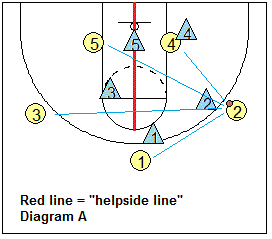
Defenders whose man is two passes away are in "helpside", and are "up the line" sagging into the lane (paint) area. Helpside positioning almost looks like a zone away from the ball and puts our defenders in a better position to help prevent inside passing and dribble-penetration.
Helpside defenders should never lose sight of their man and should use their peripheral vision to always see the ball and their man. Some coaches call this the "pistols position" pretending that your index fingers are pistols, with one pistol pointing at the ball and the other pointing at your man. Some use the term "ball-you-man" to emphasize this point.
Once the ball gets in the corner, all helpside defenders should have one foot on the helpside line (Diagram B). You can see in this diagram that our X5 defender is in a good position to slide over and provide backside defense to the over-the-top lob pass to O4. And X4 is in a good position to deny the pass to O4 and also deny dribble-penetration by O2 (Diagram C).
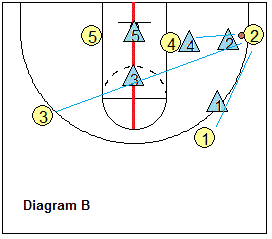
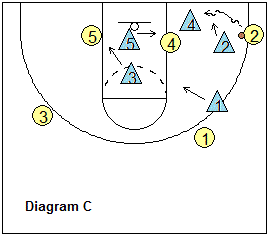
Notice how X5 and X3 rotate in this situation. Also notice in Diagram B, that whenever the ball is below the free throw line, the helpside defenders should have one foot on the helpside line.
Now in Diagram D below see how the defense shifts and rotates on the "skip pass" across court to O3. Not shown in the diagram, if O4 flashes to the ball-side elbow, X4 will move up and try to keep a hand in front denying O4 that pass, while X2 (in helpside) can drop down a little lower in the paint in the event of the over-the-top lob pass to O4.
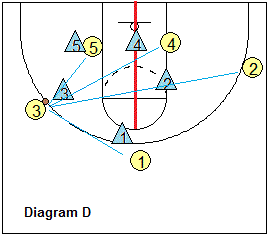
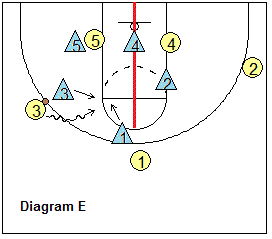
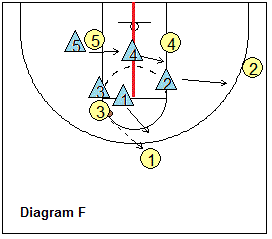
Help and Recover
Diagrams E and F teach how to help and recover on the perimeter. This is necessary because when you play tight pressure defense on the ball, there are going to be times when the on-ball defender gets beat off the dribble. To stop dribble-penetration, the adjacent perimeter defender gives help, hedging toward the ball, preventing the dribble move.Here is a tip: if you are playing against a team with a very good penetrating guard, rather than playing a "full-denial", defenders one pass away can play a little up the line and step or two toward the ball in order to help stop the dribble penetration. On the other hand, if one of the help defenders is guarding their star outside three-point shooter, you would probably rather keep that defender in a deny position and not leave his man to give help. It helps to know your opponent.
In Diagram E, O3 tries to dribble-penetrate. The X1 defender gives help and O3 is prevented from penetrating, and has to dish back out to O1 (Diagram F). The X1 defender then has to rotate quickly out to on-ball defense on O1, and the X2, X3 and X4 defenders are now in deny, while the X5 defender moves into help-side (Diagram F). Important teaching point: in teaching help and recover, you must drill your help defenders to move their feet quickly to establish position to prevent the dribble move. They must not simply "reach-in" and take a swipe at the ball.
"Defense is all about helping. No one can guard a good dribbler, You have to walk kids through how to help and then how to help the helper." - Bob Knight
From "Bob Knight: The Complete Guide to Man-to-Man Defense"
Man-to-Man Defense - Point-guard dribble-penetration.
I personally believe that the two main things that cause problems for man-to-man defense are (1) point guard dribble-penetration, and (2) the pass getting into the low post. In both situations, something bad usually happens... a basket or a foul.We prefer to give up outside jump shots, not lay-ups and free-throws. It's important to keep guards from penetrating from the top. First, when the ball is at the top (in the middle) there is no helpside defense established, since all defenders must play their own man in deny at that point. So when the point guard penetrates, one of our low post defenders has to rotate over, leaving his/her man open, and he/she may foul the point guard.
We want the point guard defender to play fairly "straight-up", and even over-guard the offensive player's right or left side, depending on which way he/she likes to go. The point defender must work hard with good footwork and stay in front of the offensive player.
We often have to make adjustments depending on the offense's strengths and weaknesses. If their point guard mainly is a penetrator, we have our point defender back off a step and invite the outside shot instead. We have our wing defenders "hedge" and give "help and recover" in trying to deny dribble-penetration. Wing defenders move a little "up the line" into the gaps (see diagram), seeing the ball and their man, without getting beaten by the wing back-cut.
When the on-ball defender is beaten, the adjacent perimeter defender sprints over to stop the dribble, switching with the original on-ball defender. In the diagram below, X1 gets beat, so X3 stops O1's dribble as X1 now takes O3. This is better than expecting an inside post defender to stop the dribble, as this often leaves the opponent's post player open for an inside pass.
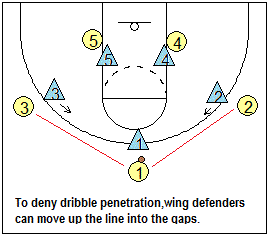
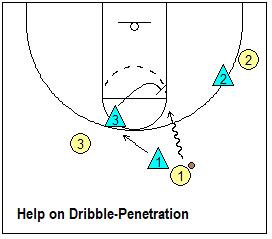
Man-to-Man Defense - Baseline dribble-penetration.
We deny dribble-penetration along the baseline. See the diagrams below. In diagram A, the on-ball defender X2 forces the dribbler to the baseline. The low post defender X4 (who is fronting the post on the baseline side) immediately rotates to the baseline, stops the ball, and double-teams with the wing defender X2.Meanwhile, the opposite post defender X5 rotates to cover the vacated post player O4, while the opposite helpside wing defender X3 drops down to protect the weakside. Once the ball is trapped at the baseline, we go for the five-second count, and anticipate and intercept a bad pass (diagram B). Notice that X1 gets in the gap between O1 and O3, looking to intercept a pass, or contain on the skip pass.
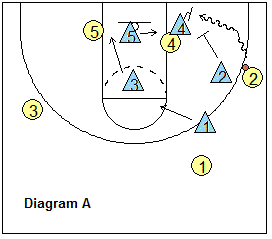
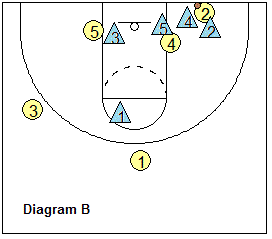
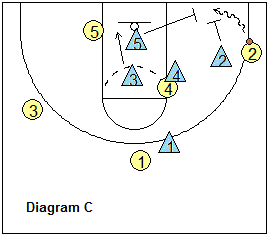
Diagram C shows a more frequent situation. O4 has moved up to the elbow, to clear-out for O2's move to the hoop. Here, X5 immediately rotates to stop O2 along the baseline, while X3 drops to cover the weakside.
This works very well, but you must drill this in practice so it becomes automatic. The most common errors are X5 and/or X3 rotating too slowly. X5 should be moving out as soon as he/she sees O2 starting the dribble to the baseline. And as soon as X3 sees X5 leaving, he/she must drop down inside.
Related pages:
- Man-to-Man Pressure Defense (Part 2) - post defense, cutters, special situations
- Man-to-Man Pressure Defense (Part 3) - defending screens
- Switching Man-to-Man Defense
- Bob Kloppenburg's SOS Defense
- Teaching Defense and How to Defend Screens by Progression
- Defending the Pick and Roll
- Basic Defense
- Shell Drill
- Man-to-Man Breakdown Drills
- Man-to-Man Positioning Drill
- 1-on-1 Drill
- Defensive Close-Outs and Drills
- Taking The Charge - Tips and Drills